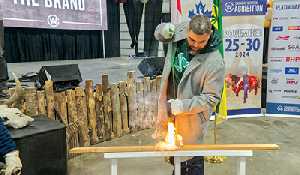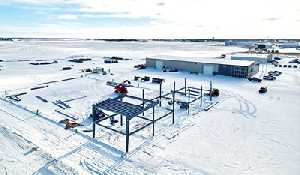Sask Potash mines bringing in billions more
October 31, 2022, 7:41 am
Kevin Weedmark


With potash prices soaring and capacity increasing, Saskatchewan’s potash industry, including the two largest potash mines in the world—Nutrien Rocanville and Mosaic Esterhazy—are bringing in billions more in potash sales than a year ago.
The potash sector in Saskatchewan hit all-time record highs in 2021, with production reaching 14.2 million tonnes K2O and the value of sales hitting $7.6 billion.
With the Russian invasion of Ukraine and subsequent sanctions against Russia and Belarus, the price of potash has more than tripled this year from last year—from $245.95 a tonne in May of 2021 to $749.27 a tonne in September, 2022. The potash price soared from $278.79 in January of this year to $498.27 in February to $712.42 in March, and has remained elevated, and on an upward trend, since then.
With the higher prices, potash producers are ramping up production.
Nutrien will be ramping up annual potash production capability to 18 million tonnes by 2025, up 5.0 million tonnes, or 40 per cent, compared to 2020.
Mosaic is also taking steps to increase its annual potash capacity by a further 1.5 million tonnes at the Esterhazy K3 operation and the Colonsay mine.
“In 2021, we produced five million metric tonnes at the Rocanville site,” said BJ Arnold of Nutrien. “The site currently runs at capacity and our production will be similar for 2022 and through to 2025.”
The five million tonnes produced at Nutrien Rocanville in 2021 is more than a third of total production in Saskatchewan last year.
Saskatchewan is the largest potash producer in the world and the sole producer in Canada, typically accounting for about 30 per cent of global potash production. Over the last 15 years, the potash industry has committed approximately $30 billion of investment for new mines and expansions.
While Nutrien says it plans to increase potash production capability by nearly one million tonnes across its Saskatchewan mines in 2022, it also says it is looking at long term plans
“Nutrien is responding to this period of unprecedented market uncertainty by safely expanding potash production to help provide our customers with the crop inputs they need. We continue to closely monitor market conditions and will evolve our long-term plans to ensure we utilize our assets in a safe and sustainable manner that benefits all our stakeholders,” said Ken Seitz, Nutrien’s Interim President and CEO.
Nutrien’s 2022 potash production is expected to increase by nearly 20 per cent compared to 2020 and account for more than 70 per cent of global production added over this period.
Nutrien says it “continues to evaluate additional low-cost brownfield (existing mine) expansion opportunities at its Saskatchewan mines that would supply longer-term market demand growth.”
Elsewhere in the province, K+S Potash plans to increase production to 4.0 million tonnes per year over the next few decades at their Bethune facility and BHP is looking to accelerate the timeframe for the construction of its $12 billion Jansen project, the largest investment in Saskatchewan’s history.
Saskatchewan’s potash sector accounts for approximately 11 per cent of provincial GDP and supports roughly 6,000 direct and indirect jobs.
The Saskatchewan potash sector accounts for about 30 per cent of world production, which comes from ten mines operated in the province by Nutrien, Mosaic, and K+S Potash.



































